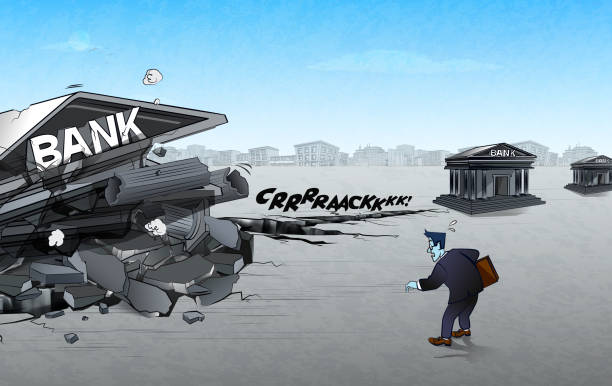Is Another Banking Crisis Lurking in India? Understanding the Risks
In the complicated banking world, crisis triggers often evolve, shifting from one sector to another. The last banking crisis in India was fueled by loans to large industries and infrastructure projects. Today, ominous signs suggest that the next crisis might be lurking in a different corner of the financial landscape — the Micro, Small, and Medium Enterprises (MSMEs) and personal loans sector.
The Reserve Bank of India (RBI), the country’s central banking institution, has been proactive in warning banks and Non-Banking Financial Companies (NBFCs) about the potential risks associated with personal loans; however, these cautionary signals were largely ignored.
Thus, on November 16, the RBI took a decisive step by instructing banks and NBFCs to fortify their defences and stringent measure was put in place, requiring an additional 25 per cent capital on personal loans, excluding a few categories like housing, education, vehicle, and loans secured by gold and gold jewellery.
The rationale behind this move is clear — the RBI aims to curb the rapid growth of unsecured personal loans. By demanding increased capital, the central bank seeks to prepare financial institutions for a potential surge in non-performing loans, urging them to either slow down the pace of lending or fortify their capital buffers.

The Unfolding Credit; Large Industries vs. Personal Loans
To comprehend the RBI’s focused intervention on unsecured personal loans, one must examine the trajectory of credit growth in India.
Historically, large industrial credit played a pivotal role in driving economic growth. However, the scenario has changed dramatically.
The period of the second term of the Modi government, we witnessed a meager 2 per cent growth in credit to large industries and infrastructure projects. In contrast, there has been a staggering surge in personal credit, particularly unsecured loans.
As of September 22, 2023, outstanding personal loans have skyrocketed to Rs 48.27 trillion, displaying an annual growth rate of 40 per cent.
Likewise, the exponential rise in unsecured personal loans from Rs 7.4 trillion in 2018-2019 to Rs 16.01 trillion by September 2023 is particularly concerning.
The RBI’s decision to address this specific segment reflects the growing stress in the household sector, compounded by the lowest growth in household net financial savings in 47 years.

Micro, Small, and Medium Enterprises (MSMEs); A Ticking Time Bomb?
While the RBI has turned its attention to unsecured personal loans, another potential risk looms in the MSMEs sector; despite their exclusion from additional capital charges for now, MSMEs are not immune to troubles.
In recent years, these enterprises have received special regulatory treatment, including priority sector lending status, lower capital requirements, and extended restructuring of non-performing loans.
The MSMEs, especially during Modi 2.0, enjoyed substantial incentives such as interest rate rebates and protections under schemes like the Emergency Credit Line Guarantee Scheme (ECLGS).
These incentives have propelled bank credit to MSMEs from Rs 12.32 trillion in 2018-2019 to Rs 21.70 trillion as of September 22, 2023, growing at a Compound Annual Growth Rate (CAGR) of over 13.4 percent in four-and-a-half years.
However, defaults in the MSMEs’ credit portfolio have increased, and the government has made provisions for payment of first losses under the ECLGS. Despite these warning signs, the RBI has spared MSMEs from enhanced regulatory treatment so far, raising concerns that they might be the next major segment to generate non-performing loans.

Restoring a Sound Risk-Based Credit Culture Is The Need of the Hour
Banks, particularly public sector banks, have aggressively expanded personal and MSME credit to align with government priorities. However, this expansion has led to these two segments constituting more than 25 per cent of the total outstanding bank credit, surpassing outstanding loans to large industries and infrastructure by about 40 per cent.
The risk-based credit culture, crucial for the stability of the banking sector, has taken a backseat amid regulatory forbearance and government guarantees.
Hence, the RBI’s latest intervention serves as a wake-up call to roll back the special treatment afforded to certain sectors and re-establish a risk-based credit culture, and failure to do so may pave the way for the next banking crisis, reminiscent of the previous one triggered by loans to large industries and infrastructure projects. As the RBI rightly cautions, the time to act is now, before the risks transform into a full-blown crisis.
Recent History of Bank Failures, Government Interventions- A Delicate Balancing Act
In recent years, India has witnessed a series of banking crises, marked by the failure of financial institutions and the need for government interventions.
The most notable among these was the crisis triggered by loans to large industries and infrastructure projects; in response, the government and the Reserve Bank of India (RBI) implemented measures to stabilize the banking sector, including bailouts and financial support.
During the large industrial credit collapse, the government played a crucial role in averting a systemic meltdown. The government injected capital into struggling banks, provided financial guarantees, and implemented measures to recapitalize and strengthen the financial system.
These interventions were aimed at preventing a domino effect that could have had severe repercussions on the broader economy.
However, the recent shift in the credit landscape, with an alarming rise in unsecured personal loans and potential risks in the MSME sector, presents a different set of challenges.
The RBI’s move to demand an additional 25 per cent capital on personal loans is a preemptive measure to mitigate the risk of a future crisis.
The question arises-Can the same playbook of government intervention, including bailouts, be applied this time, or will the circumstances prove more complex?

New Risks; Unsecured Personal Loans and MSMEs
The banking sector’s exposure to unsecured personal loans has surged, and the RBI’s decision to increase capital requirements reflects a concern about the growing stress in the household sector.
Unlike loans to large industries, personal loans often lack collateral, making them riskier for banks. With outstanding personal loans reaching Rs 48.27 trillion as of September 22, 2023, the potential for non-performing loans is significant.
Similarly, the MSME sector, despite its exclusion from additional capital charges for now, presents a looming risk. The incentives and protections provided to MSMEs have driven credit growth, but defaults are on the rise.
While the government has made provisions for first-loss payments under schemes like the ECLGS, the RBI’s decision to spare MSMEs from enhanced regulatory treatment indicates a potential challenge in addressing defaults in this segment.

Government’s Dilemma- Balancing Growth and Stability
The government faces a delicate balancing act between fostering economic growth and maintaining financial stability.
While interventions in the past have successfully averted crises, the current dynamics pose unique challenges; the sheer size and rapid growth of unsecured personal loans, coupled with the complexity of the MSME sector, require a nuanced approach.
The efficacy of a bailout strategy hinges on the government’s ability to navigate the intricate tangle of household debt and MSME defaults. Unlike the previous crisis, where the focus was on large industries, the dispersion of risk in personal loans and MSMEs makes targeted interventions more challenging. Moreover, the government must consider the potential strain on fiscal resources and the need to restore a risk-based credit culture.
A Resilient Future Amidst Uncertainty
As India’s banking sector navigates these uncharted financial waters, it becomes evident that the traditional playbook of government interventions may need adaptation.
The past successes in averting crises cannot guarantee a smooth sail this time, given the intricacies of household debt and the complexities within the MSME sector. Crafting a resilient future demands a comprehensive strategy, combining regulatory foresight, targeted interventions, and a commitment to restoring a risk-based credit culture.
The government faces the delicate task of balancing fostering economic growth and ensuring financial stability, and the key to success lies in timely and proactive measures that address the root causes of emerging risks.
The Last Bit, While the government has successfully tackled banking crises in the past, the evolving nature of risks in unsecured personal loans and MSMEs presents a unique challenge.
A comprehensive strategy that combines regulatory measures, targeted interventions, and a commitment to restoring a risk-based credit culture is imperative.
The government must carefully assess the potential impact on economic growth and financial stability, recognizing that the playbook used in the past may require adaptation in these uncharted waters effectively.



